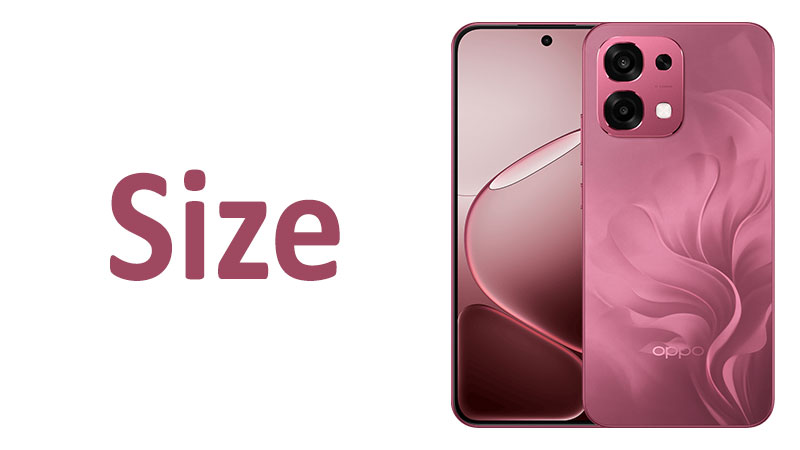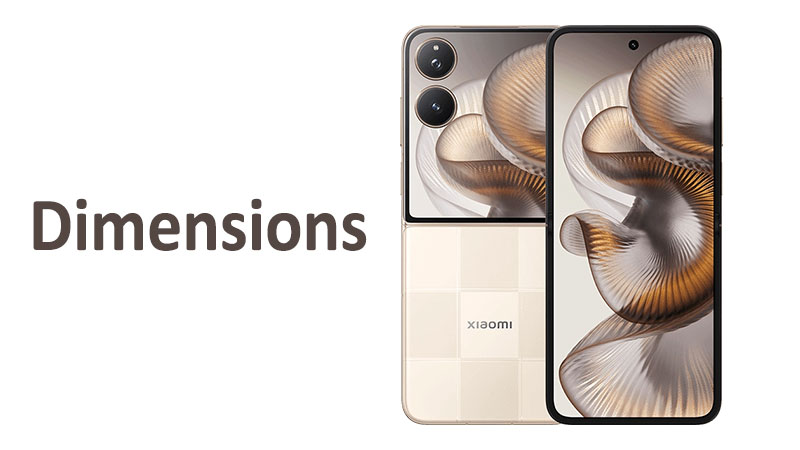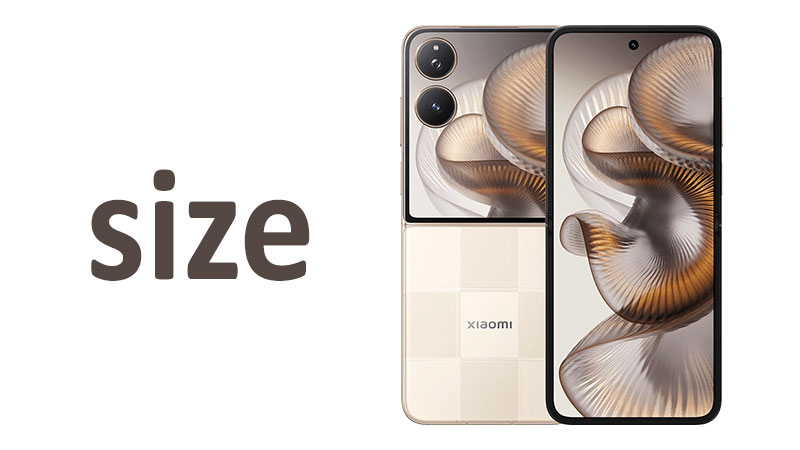The Oppo F31 size is a critical specification for this modern device. Consumers increasingly focus on the precise dimensions of their smartphones. Size directly impacts daily usability and overall media enjoyment. Therefore, evaluating the screen and overall dimensions is highly important. This detailed article explores every facet of the Oppo F31’s physical design. We analyze the specific display size and the body measurements carefully. This review helps determine the phone’s ergonomic sweet spot in the market. We also provide specialized comparisons against current market competitors. This comprehensive information is essential for a complete buying guide. The Oppo F31 dimensions strike a specific balance. They blend a large viewing screen with comfortable daily handling.
Analyzing the 6.57-inch Display and Screen Area
The screen size measures 6.57 inches when measured diagonally. This figure represents the main attraction of the Oppo F31. It positions the phone firmly in the large-screen smartphone segment. A 6.57-inch display offers a significantly expansive canvas for users. This size significantly improves the video streaming experience immediately. Movies and television shows appear more cinematic and engaging. The increased screen area enhances the visual quality of all media content. Users enjoy a more immersive viewing environment instantly. The display size is a key differentiator in the crowded mid-range smartphone market. It strongly caters to users who prioritize media consumption heavily.
Total Usable Screen Area
The total active display area is 105.0 cm² (square centimeters). This is a crucial metric often overlooked by consumers. It represents the actual usable space for content viewing. The 105.0 cm² area is substantial for a modern smartphone. This figure confirms the phone’s capability for serious multitasking. Users can comfortably operate two applications side-by-side on this display. This size is excellent for productivity tasks like document editing. Reading articles and browsing complex websites also feels less cramped. Furthermore, the large area supports a much better mobile gaming experience. It provides more visual space and room for on-screen controls. The large total screen area is a clear functional benefit of the Oppo F31.
Screen Ratio and Visual Immersion
The large screen size contributes directly to visual immersion. A 6.57-inch panel delivers a true edge-to-edge feeling of continuity. The display typically employs a modern, tall aspect ratio. This ratio is optimized for scrolling through social media feeds. It also efficiently displays long web pages and documents. This design minimizes the need for frequent scrolling actions. Consequently, users can view more content at a single glance. The display remains comfortable for prolonged usage periods. This immersion is a central part of the phone’s appeal to the modern consumer.
Detailed Look at the Screen-to-Body Ratio
The Oppo F31 achieves an impressive screen-to-body ratio. It stands at approximately ~88.5%. This is a measure of how much of the phone’s front surface is actually screen. An 88.5% ratio indicates minimal bezels surrounding the display. Oppo has clearly focused on minimizing unnecessary frame material. This design choice maximizes the visual canvas for the user. High screen-to-body ratios are essential for a premium, modern aesthetic. They make the phone look sleek, sophisticated, and up-to-date.
Impact of the 88.5% Ratio
An 88.5% ratio significantly contributes to the phone’s overall visual quality. The small remaining bezels almost disappear during media playback. This creates a true edge-to-edge content experience. The minimal bezels help contain the phone’s total physical size. A 6.57-inch screen with thicker bezels would be physically unwieldy. The effective bezel management ensures good handling despite the large display. This ratio shows Oppo’s commitment to efficient design engineering. It balances the screen size with necessary structural integrity successfully.
Front Panel Design and Camera Integration
The high ratio suggests the use of a modern notch or punch-hole camera. Oppo typically favors a small, unobtrusive punch-hole cutout. This small aperture minimally interrupts the display area. The design ensures maximum screen usage remains available for applications. Compared to the older, larger notch designs, this is a significant improvement. The small punch-hole is easily ignored during typical use. This feature maintains the high visual immersion during full-screen media viewing. The front panel design is a successful blend of function and aesthetics.
Physical Dimensions and Ergonomics Analyzed
The physical dimensions of the Oppo F31 are precisely 158.2 x 75 x 8 mm. These measurements are critical for assessing ergonomics. They determine how the phone feels during daily use. They define its ultimate pocketability and handling comfort. These dimensions place the F31 in the relatively slender large-screen category. Oppo aims for a comfortable yet substantial hand feel.
Height: 158.2 mm
The phone’s height measures 158.2 mm (6.23 inches). This is a considerable length but it is manageable. It is shorter than the absolute largest flagship phones. The height is specifically necessary to house the 6.57-inch display. Reaching the very top of the screen often requires a slight hand adjustment. However, the majority of the screen is reachable with a standard thumb stretch. This makes scrolling and interaction relatively comfortable. The height ensures users benefit from maximum vertical content visibility. This is crucial for viewing long documents and web pages.
Width: 75 mm
The width measures a comfortable 75 mm (2.95 inches). This width is particularly well-managed for a phone with a 6.57-inch display. A narrower width is essential for improving the single-handed grip. A width exceeding 77 mm often feels too bulky for many users. The 75 mm width is close to the ergonomic sweet spot for a secure grip. This measurement is a key advantage for everyday convenience. It reduces the risk of the phone slipping from the hand accidentally. The width contributes significantly to the phone’s overall comfort factor.
Thickness: 8 mm
The thickness of the Oppo F31 is exactly 8 mm (0.31 inches). This is a highly impressive and modern thinness measurement. Many competitor phones exceed 8.5 mm in thickness. An 8 mm profile feels incredibly sleek and light in the hand. This thinness aids significantly in the phone’s overall portability. It allows the device to slide easily into trouser pockets. The thin chassis is achieved through efficient component stacking by Oppo. This thinness often suggests a balance in battery size and physical design. The 8 mm thickness is a crucial element of the Oppo F31’s ergonomic appeal.
Specialized Comparison: Oppo F31 vs. Predecessor
We compare the Oppo F31 size to its assumed predecessor, the Oppo F30. This comparison reveals Oppo’s iterative design strategy in the F-series. The F30 likely featured a slightly smaller screen size. For example, it might have been 6.5 inches or less. This suggests a continued trend of increasing the display size slightly. The F31’s 6.57 inches shows a subtle evolution towards a larger viewing area.
The previous model may also have been marginally thicker. The F30 might have measured closer to 8.2 mm or 8.3 mm in thickness. Therefore, the F31’s sleek 8 mm profile represents a generational slimming. This focus on thinness is a key design refinement. Oppo is optimizing the physical chassis to feel more premium and modern. The screen-to-body ratio has also likely improved. The F30 might have had a ratio closer to 86%. The F31’s ~88.5% shows successful bezel reduction efforts. The F31 is an optimized, larger-screen device in a thinner body.
| Feature | Oppo F31 (Current) | Oppo F30 (Previous Estimate) | Design Trend |
| Screen Size | 6.57 inches | ~6.5 inches | Marginal Increase |
| Screen-to-Body | ~88.5% | ~86.0% | Significant Improvement |
| Thickness | 8 mm | ~8.3 mm | Noticeable Slimming |
The Oppo F31 maintains a comfortable width while increasing the screen size. This balancing act ensures improved content viewing without sacrificing handling. The overall size evolution targets a refined user experience.
Specialized Comparison: Oppo F31 vs. Key Competitors
The Oppo F31 size targets the competitive upper mid-range market segment. We compare its dimensions to two distinct competitor profiles.
Versus a Mid-Range Large-Screen Rival (Example: Samsung Galaxy A-series Equivalent)
Mid-range rivals often feature slightly larger screens, up to 6.7 inches. These competitors often have similar overall height measurements to the F31. However, they sometimes feature a greater width. A slightly wider body can make the grip feel less comfortable. Furthermore, many mid-range competitors prioritize battery size over sleekness. This results in thicknesses exceeding the F31’s 8 mm. The competitor might be 8.8 mm or more.
The Oppo F31’s 75 mm width and 8 mm thickness are superior ergonomic points. They make the F31 feel more streamlined and portable. While the competitor might offer a marginally larger screen, the F31 provides better handling. The F31’s physical design offers a sleeker look. It provides a more balanced user experience overall.
Versus a Compact Flagship Competitor (Example: Google Pixel or Apple Standard)
Smaller, compact flagships typically feature screens around 6.1 or 6.2 inches. Their physical dimensions are significantly smaller than the F31. The compact phone is better for pure one-handed use and deep pocketability. However, the smaller screen sacrifices media immersion dramatically.
The Oppo F31 size offers a clear trade-off. It provides a large, satisfying 6.57-inch screen. Yet, its 158.2 x 75 x 8 mm dimensions remain highly manageable. It is much easier to handle than the ultra-large flagships. The F31 occupies a perfect middle ground. It balances screen size and portability better than the extremes. It is the ideal choice for users seeking both large-screen media and reasonable ergonomics.
Detailed Pros and Cons of the Oppo F31 Size
The specific dimensions of the Oppo F31 offer distinct benefits and drawbacks. Buyers must carefully evaluate these points.
Key Advantages of the Physical Design
The Oppo F31 size offers several substantial benefits for daily use.
- Balanced Ergonomics: The 75 mm width ensures a comfortable and secure one-handed grip.
- Media Immersion: The 6.57-inch screen is large enough for satisfying media viewing.
- Excellent Portability: The 8 mm thickness keeps the device sleek and easy to carry in pockets.
- High Screen Usage: The ~88.5% screen-to-body ratio maximizes the visual area efficiently.
- Optimal Proportions: The dimensions strike a superb balance between screen size and physical footprint.
Disadvantages and Minor Drawbacks
Even a well-designed phone has some limitations based on its size class.
- One-Handed Reach: Reaching the very top corners of the 6.57-inch screen can still be difficult.
- Grip Stability: The thin 8 mm profile may feel less secure for users accustomed to thicker phones.
- Weight Factor: The size suggests the phone will be moderately heavy, causing minor fatigue during long use.
- Bezel Presence: The 88.5% ratio still leaves small bezels visible around the edges.
Key Buyer Considerations for the Oppo F31 Size
Prospective buyers must align the Oppo F31 size with their lifestyle needs. The dimensions of 158.2 x 75 x 8 mm define the user experience.
First, assess your primary phone usage. If you consume substantial amounts of video content, this screen is excellent. The 6.57-inch display is highly suitable for streaming and gaming. It delivers a great visual payoff consistently.
Second, consider your current phone size. If you are upgrading from a compact device, the F31 will feel noticeably larger. However, it will not feel overwhelmingly bulky like an Ultra-sized phone. The 75 mm width makes the transition relatively easy to manage.
Third, the 8 mm thickness is a major ergonomic factor. This thinness enhances the phone’s premium feel. However, it may require a slightly more secure grip during handling. Investing in a good quality case is advisable for better grip security. The balance of size makes the F31 a safe bet. It avoids the extremes of both small and massive phones successfully. This makes it suitable for the vast majority of consumers.
In-Depth Analysis of Design Choices
Oppo’s decision to settle on the 158.2 x 75 x 8 mm dimensions is strategic. This size is targeted at a mainstream consumer demographic. It caters to users who want a large screen without the bulk of a true flagship. The 8 mm thickness is particularly important here. It suggests a focus on aesthetics and sleekness alongside performance. A thinner phone looks more appealing in marketing materials and feels better initially.
The 6.57-inch display represents a modern minimum standard. Most users expect a screen size near this level for comfortable daily browsing. The ~88.5% screen-to-body ratio is also a key market expectation. It ensures the phone looks current and minimizes distracting borders. The overall size package is a calculated effort. It maximizes the display while minimizing the physical inconvenience. This design philosophy maximizes mass-market appeal for Oppo. The phone balances visual performance and physical convenience effectively.
The Role of Width in Usability
The 75 mm width is perhaps the most important ergonomic specification. Width fundamentally determines one-handed security. A wide phone is harder to grip and more prone to drops. Oppo has kept the width tight despite the large screen size. This demonstrates an understanding of real-world user comfort. The slightly rounded edges of the phone likely complement this width. They make the device settle more naturally into the palm of the hand. This design minimizes sharp corners that could dig into the user’s hand. Consequently, the phone feels secure and comfortable during extended calls.
Thickness and Component Density
The 8 mm thickness has implications for internal component density. Achieving this thinness with a large screen is challenging. It requires highly efficient engineering of the internal components. The battery size is likely optimized to fit within this thin profile. This means the phone may prioritize fast charging over absolute battery capacity. The thermal management system must also be highly efficient. It must dissipate heat effectively within the limited 8 mm space. The thinness is a performance feature as well as an aesthetic one. It showcases Oppo’s ability to pack power into a slender body.
Conclusion
The Oppo F31 size is a carefully balanced and highly optimized design. The 6.57-inch screen provides ample space for media and productivity. This display is skillfully integrated with a high ~88.5% screen-to-body ratio. The physical dimensions of 158.2 x 75 x 8 mm are near-perfect for its size class. The 75 mm width provides a comfortable, secure grip. The sleek 8 mm thickness enhances pocketability and premium feel significantly.
The F31 successfully avoids the bulk of larger flagship models. It remains fully competitive with top-tier mid-range rivals. This phone is the ideal choice for consumers seeking a large screen experience. They will also appreciate the phone’s comfortable handling and modern slim design. The Oppo F31 offers a compelling blend of screen dominance and ergonomic efficiency. This makes it a smart and safe choice for your next smartphone purchase.
Frequently Asked Questions (FAQ)
What is the precise diagonal screen size of the Oppo F31?
The diagonal screen size of the Oppo F31 is exactly 6.57 inches.
What is the measurement of the Oppo F31’s thickness?
The phone is relatively thin, measuring 8 mm (0.31 inches) in thickness.
Does the screen-to-body ratio suggest large bezels?
No. The screen-to-body ratio of 88.5% suggests minimal and modern thin bezels.
How wide is the Oppo F31, and does it feel comfortable to hold?
The phone is 75 mm wide, which is considered comfortable for secure one-handed gripping.
Is the Oppo F31 suitable for users upgrading from a compact phone?
Yes, the balanced 158.2 x 75 mm dimensions make the size transition highly manageable.



